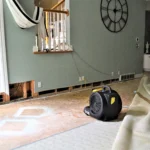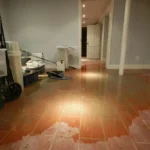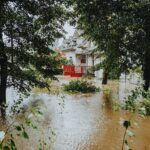Introduction
Water damage restoration is a challenging and extensive process of restoring a property to its pre-damaged state. The streamlined process involves multiple stages, including water removal, drying and dehumidification, cleaning, and repairing. It prevents further structural damage, mitigates mold and mildew growth, and helps to preserve the property value, potentially saving money on insurance claims. The process aims to address not only the visible water damage but also the hidden moisture to prevent future issues.
What to Expect from the Water Damage Restoration Process?
Are you feeling overwhelmed by the water damage in your home and unsure of what to do and where to begin? Catastrophic moments like these can paralyze us momentarily, and hiring professional services is the best way to ensure the safety of ourselves, our families, and our property. To mitigate the damage, quick actions by professional services reduce the overall cost of repairs and downtime, getting you back to normal life faster.
Here is a step-by-step walk-through of exactly what to expect from the water damage restoration process.
- Initial Assessment and Mitigation
- Initial inspection: A professional restoration service assesses the extent of water damage, identifying the source and the scope of the problem. They will meticulously evaluate the extent of damage to determine which materials and sites can be restored.
- Water extraction: The cleanup services utilize specialized equipment like extractors and industrial-grade vacuums to remove the standing water from the area. This helps to create a drier environment to carry on the restoration task, minimizing further damage.
- Drying and Dehumidification
- Using air movers and dehumidifiers: Water damage restoration services use industrial-strength humidifiers and air movers to accelerate the drying process and remove excess moisture from the air. This step is crucial to prevent mold growth in your damaged property.
- Moisture testing: Throughout the drying process, moisture levels are monitored using moisture meters and thermal imaging cameras to ensure proper targeted drying. It helps the professionals to identify the extent of damage and plan effective drying strategies to ensure complete restoration.
- Cleaning and Sanitizing
- Cleaning affected areas: All surfaces, including walls, floors, and contents, are thoroughly cleaned and disinfected to remove contaminants and prevent mold growth. If water damage is caused by contaminated water like sewage, an antimicrobial solution is used to disinfect everything.
- Odor removal: Specialized techniques are used to eliminate any musty or lingering odors caused by water damage. Odor absorbents or neutralizing agents are used, as well as ozone or hydroxyl generators to oxidize and destroy odors at the source. Air purifiers with HEPA filters remove airborne particles and odors.
| Fast fact Broken or leaky pipes, excess humidity, roof leaks, and flooding are major contributors to water damage. |
- Repair and Restoration
- Demolition and debris removal: Damaged drywall, flooring, or insulation that can’t be salvaged are removed at this stage to prepare the property for repairs and rebuilding. This stage ensures the property is safe, structurally sound, and ready for the future renovation process.
- Repair and reconstruction: Damaged structures are repaired or replaced, and the property is restored to its pre-damaged state. This stage involves restoring the plumbing, electrical, and other systems affected by the water damage and addressing cosmetic repairs like painting or wallpapering.
- Contents Restoration
- Salvaging possessions: All the belongings and personal items are professionally cleaned, dried, and restored in this phase. Professional water damage services help you document all the damage for insurance claims.
- Final inspection and testing: A final inspection is conducted to ensure the property is completely dry and free of any lingering issues. Professional companies in this last phase of restoration ensure that the place is structurally sound and liveable before handover.
| Did you know? A significant percentage of businesses fail after natural disasters, with internal water damage claims averaging over $50,000 for commercial properties. |
Conclusion
Whether due to leaks, floods, or burst pipes, water damage restoration is a comprehensive process of restoring a property to its pre-damaged condition. It consists of several stages, including water evacuation, drying, and sanitizing before the repairs and reconstruction. Quick action is crucial to ensure the safety and health of occupants and to prevent any further structural damage to your property from secondary issues like mold growth.
Read More:




